Drones as a Mode of Public Transportation to Reduce Urban Traffic Congestion and Air Pollution
VerifiedAdded on 2023/01/10
|14
|3286
|29
AI Summary
This research proposal explores the potential of drones as a mode of public transportation to reduce urban traffic congestion and air pollution. It discusses the background of the topic, research aim, objectives, and questions. The study also examines the rationale, related work, proposed research methodology, data collection process, ethical considerations, and time horizon.
Contribute Materials
Your contribution can guide someone’s learning journey. Share your
documents today.
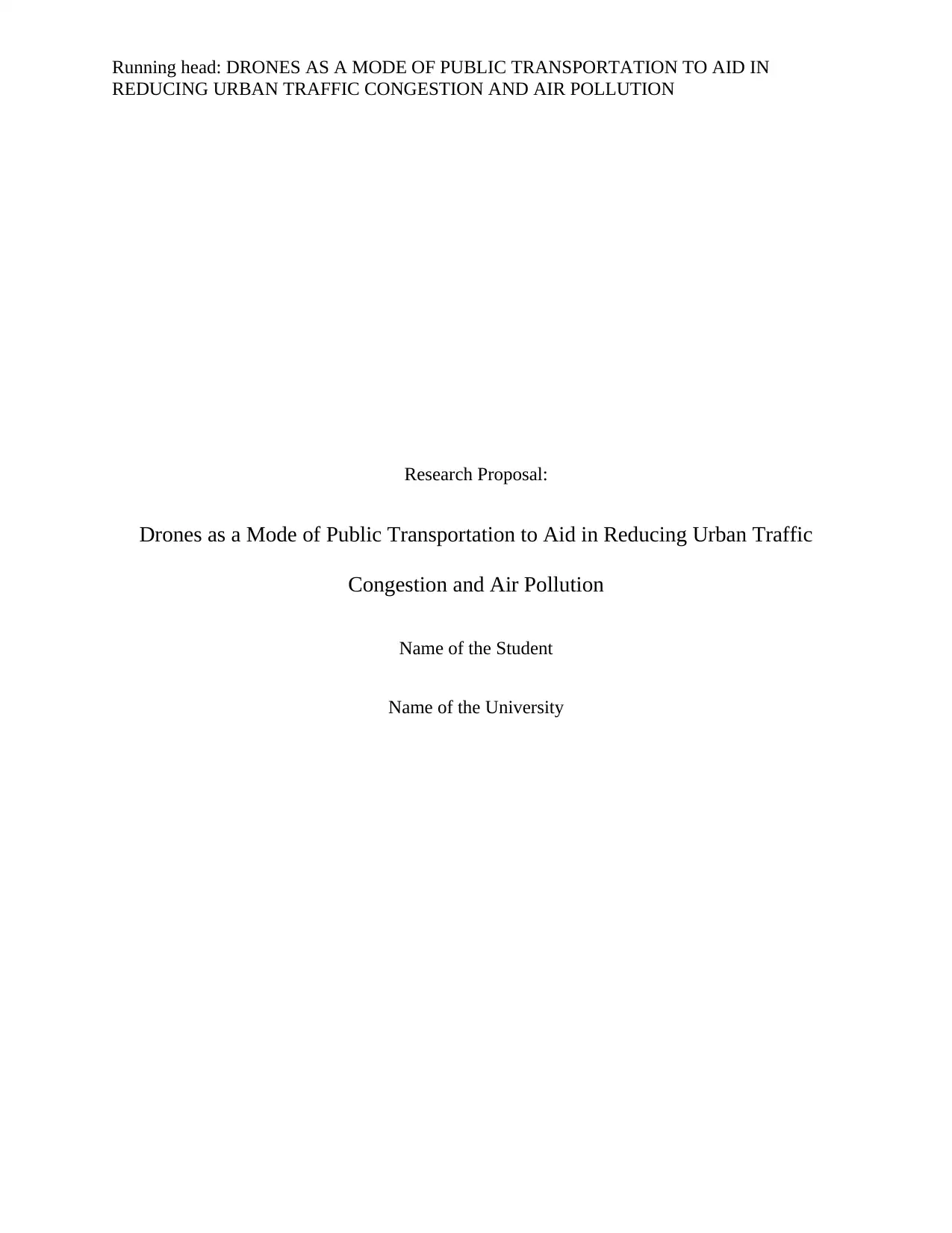
Running head: DRONES AS A MODE OF PUBLIC TRANSPORTATION TO AID IN
REDUCING URBAN TRAFFIC CONGESTION AND AIR POLLUTION
Research Proposal:
Drones as a Mode of Public Transportation to Aid in Reducing Urban Traffic
Congestion and Air Pollution
Name of the Student
Name of the University
REDUCING URBAN TRAFFIC CONGESTION AND AIR POLLUTION
Research Proposal:
Drones as a Mode of Public Transportation to Aid in Reducing Urban Traffic
Congestion and Air Pollution
Name of the Student
Name of the University
Secure Best Marks with AI Grader
Need help grading? Try our AI Grader for instant feedback on your assignments.
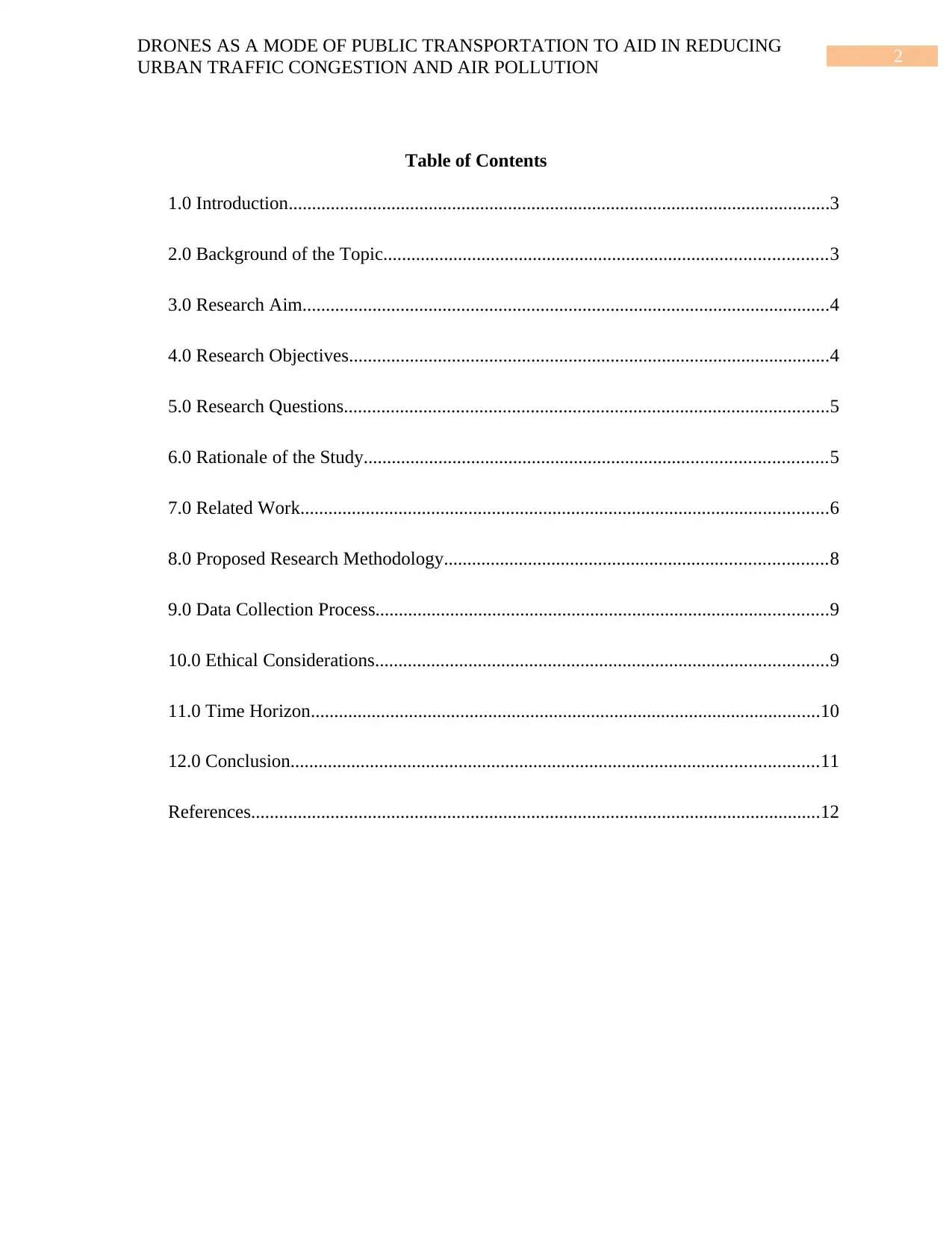
DRONES AS A MODE OF PUBLIC TRANSPORTATION TO AID IN REDUCING
URBAN TRAFFIC CONGESTION AND AIR POLLUTION 2
Table of Contents
1.0 Introduction....................................................................................................................3
2.0 Background of the Topic...............................................................................................3
3.0 Research Aim.................................................................................................................4
4.0 Research Objectives.......................................................................................................4
5.0 Research Questions........................................................................................................5
6.0 Rationale of the Study...................................................................................................5
7.0 Related Work.................................................................................................................6
8.0 Proposed Research Methodology..................................................................................8
9.0 Data Collection Process.................................................................................................9
10.0 Ethical Considerations.................................................................................................9
11.0 Time Horizon.............................................................................................................10
12.0 Conclusion.................................................................................................................11
References..........................................................................................................................12
URBAN TRAFFIC CONGESTION AND AIR POLLUTION 2
Table of Contents
1.0 Introduction....................................................................................................................3
2.0 Background of the Topic...............................................................................................3
3.0 Research Aim.................................................................................................................4
4.0 Research Objectives.......................................................................................................4
5.0 Research Questions........................................................................................................5
6.0 Rationale of the Study...................................................................................................5
7.0 Related Work.................................................................................................................6
8.0 Proposed Research Methodology..................................................................................8
9.0 Data Collection Process.................................................................................................9
10.0 Ethical Considerations.................................................................................................9
11.0 Time Horizon.............................................................................................................10
12.0 Conclusion.................................................................................................................11
References..........................................................................................................................12
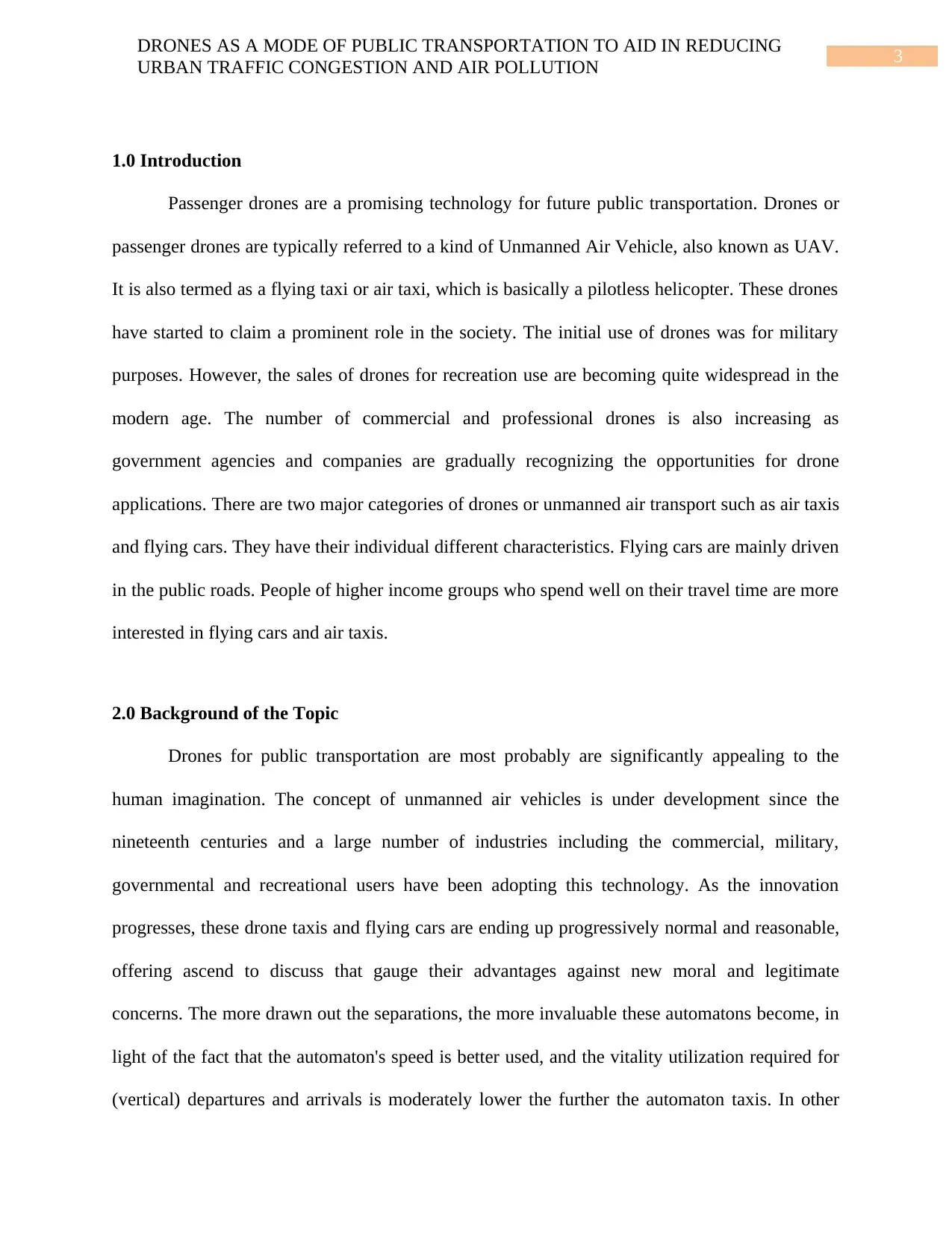
DRONES AS A MODE OF PUBLIC TRANSPORTATION TO AID IN REDUCING
URBAN TRAFFIC CONGESTION AND AIR POLLUTION 3
1.0 Introduction
Passenger drones are a promising technology for future public transportation. Drones or
passenger drones are typically referred to a kind of Unmanned Air Vehicle, also known as UAV.
It is also termed as a flying taxi or air taxi, which is basically a pilotless helicopter. These drones
have started to claim a prominent role in the society. The initial use of drones was for military
purposes. However, the sales of drones for recreation use are becoming quite widespread in the
modern age. The number of commercial and professional drones is also increasing as
government agencies and companies are gradually recognizing the opportunities for drone
applications. There are two major categories of drones or unmanned air transport such as air taxis
and flying cars. They have their individual different characteristics. Flying cars are mainly driven
in the public roads. People of higher income groups who spend well on their travel time are more
interested in flying cars and air taxis.
2.0 Background of the Topic
Drones for public transportation are most probably are significantly appealing to the
human imagination. The concept of unmanned air vehicles is under development since the
nineteenth centuries and a large number of industries including the commercial, military,
governmental and recreational users have been adopting this technology. As the innovation
progresses, these drone taxis and flying cars are ending up progressively normal and reasonable,
offering ascend to discuss that gauge their advantages against new moral and legitimate
concerns. The more drawn out the separations, the more invaluable these automatons become, in
light of the fact that the automaton's speed is better used, and the vitality utilization required for
(vertical) departures and arrivals is moderately lower the further the automaton taxis. In other
URBAN TRAFFIC CONGESTION AND AIR POLLUTION 3
1.0 Introduction
Passenger drones are a promising technology for future public transportation. Drones or
passenger drones are typically referred to a kind of Unmanned Air Vehicle, also known as UAV.
It is also termed as a flying taxi or air taxi, which is basically a pilotless helicopter. These drones
have started to claim a prominent role in the society. The initial use of drones was for military
purposes. However, the sales of drones for recreation use are becoming quite widespread in the
modern age. The number of commercial and professional drones is also increasing as
government agencies and companies are gradually recognizing the opportunities for drone
applications. There are two major categories of drones or unmanned air transport such as air taxis
and flying cars. They have their individual different characteristics. Flying cars are mainly driven
in the public roads. People of higher income groups who spend well on their travel time are more
interested in flying cars and air taxis.
2.0 Background of the Topic
Drones for public transportation are most probably are significantly appealing to the
human imagination. The concept of unmanned air vehicles is under development since the
nineteenth centuries and a large number of industries including the commercial, military,
governmental and recreational users have been adopting this technology. As the innovation
progresses, these drone taxis and flying cars are ending up progressively normal and reasonable,
offering ascend to discuss that gauge their advantages against new moral and legitimate
concerns. The more drawn out the separations, the more invaluable these automatons become, in
light of the fact that the automaton's speed is better used, and the vitality utilization required for
(vertical) departures and arrivals is moderately lower the further the automaton taxis. In other
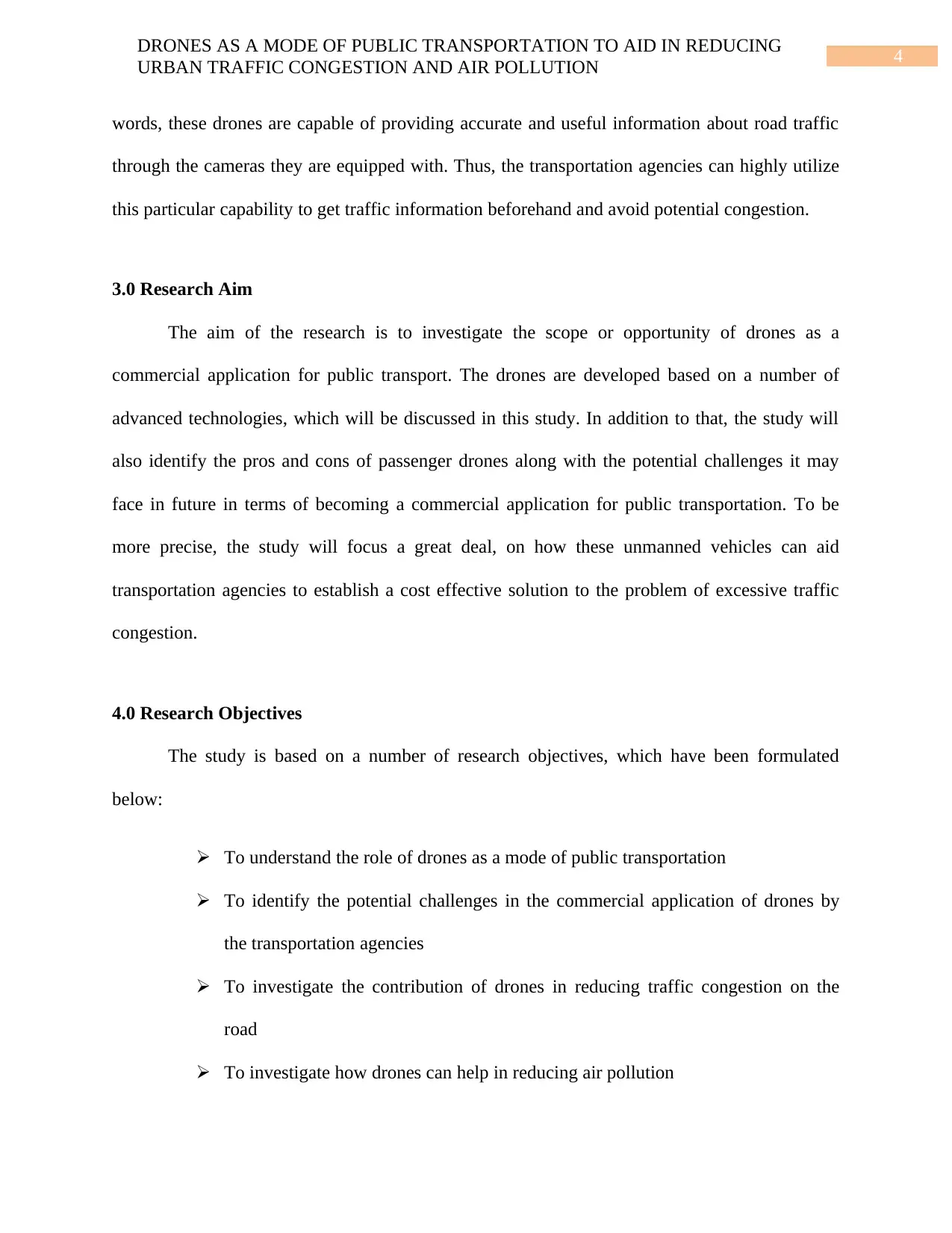
DRONES AS A MODE OF PUBLIC TRANSPORTATION TO AID IN REDUCING
URBAN TRAFFIC CONGESTION AND AIR POLLUTION 4
words, these drones are capable of providing accurate and useful information about road traffic
through the cameras they are equipped with. Thus, the transportation agencies can highly utilize
this particular capability to get traffic information beforehand and avoid potential congestion.
3.0 Research Aim
The aim of the research is to investigate the scope or opportunity of drones as a
commercial application for public transport. The drones are developed based on a number of
advanced technologies, which will be discussed in this study. In addition to that, the study will
also identify the pros and cons of passenger drones along with the potential challenges it may
face in future in terms of becoming a commercial application for public transportation. To be
more precise, the study will focus a great deal, on how these unmanned vehicles can aid
transportation agencies to establish a cost effective solution to the problem of excessive traffic
congestion.
4.0 Research Objectives
The study is based on a number of research objectives, which have been formulated
below:
To understand the role of drones as a mode of public transportation
To identify the potential challenges in the commercial application of drones by
the transportation agencies
To investigate the contribution of drones in reducing traffic congestion on the
road
To investigate how drones can help in reducing air pollution
URBAN TRAFFIC CONGESTION AND AIR POLLUTION 4
words, these drones are capable of providing accurate and useful information about road traffic
through the cameras they are equipped with. Thus, the transportation agencies can highly utilize
this particular capability to get traffic information beforehand and avoid potential congestion.
3.0 Research Aim
The aim of the research is to investigate the scope or opportunity of drones as a
commercial application for public transport. The drones are developed based on a number of
advanced technologies, which will be discussed in this study. In addition to that, the study will
also identify the pros and cons of passenger drones along with the potential challenges it may
face in future in terms of becoming a commercial application for public transportation. To be
more precise, the study will focus a great deal, on how these unmanned vehicles can aid
transportation agencies to establish a cost effective solution to the problem of excessive traffic
congestion.
4.0 Research Objectives
The study is based on a number of research objectives, which have been formulated
below:
To understand the role of drones as a mode of public transportation
To identify the potential challenges in the commercial application of drones by
the transportation agencies
To investigate the contribution of drones in reducing traffic congestion on the
road
To investigate how drones can help in reducing air pollution
Secure Best Marks with AI Grader
Need help grading? Try our AI Grader for instant feedback on your assignments.
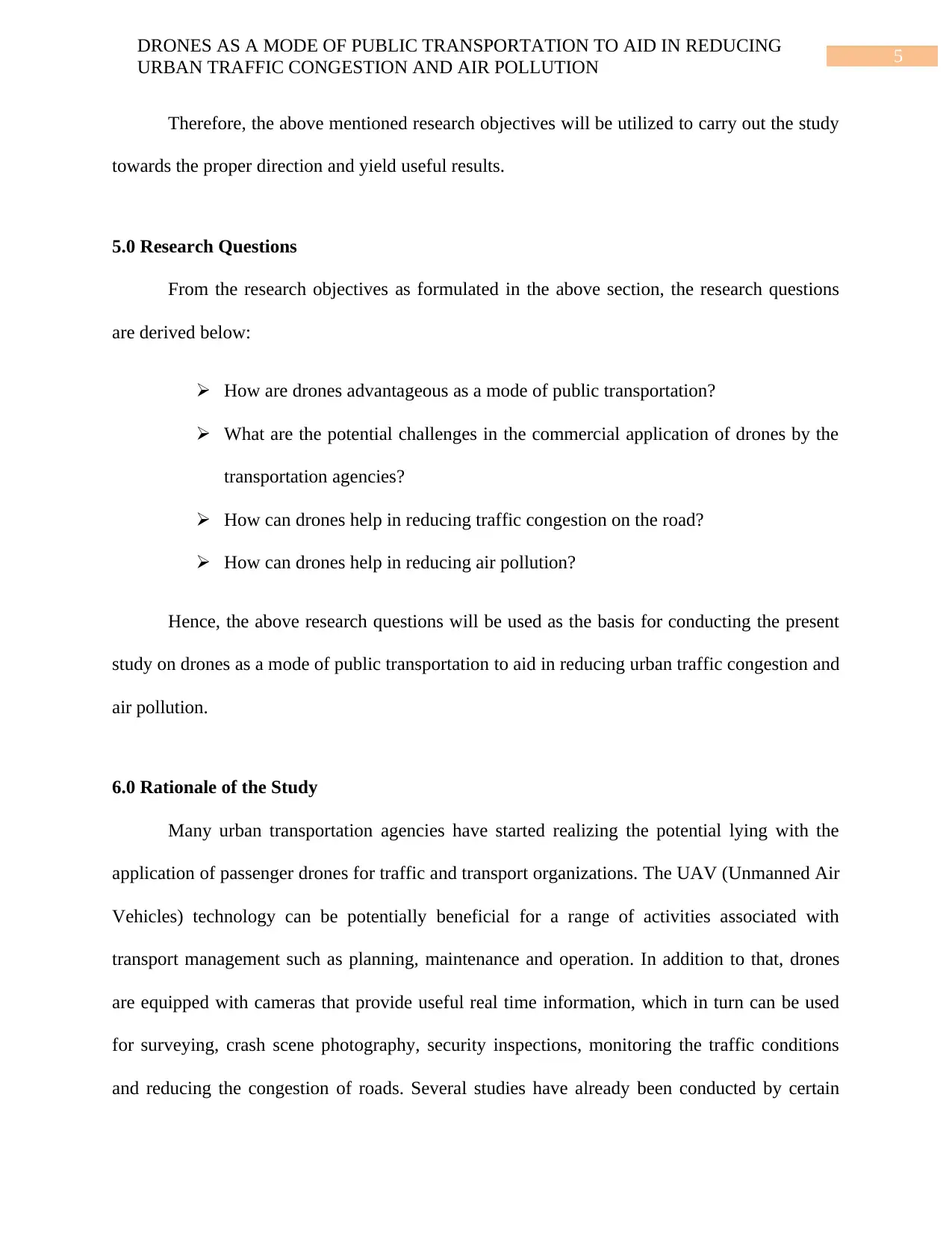
DRONES AS A MODE OF PUBLIC TRANSPORTATION TO AID IN REDUCING
URBAN TRAFFIC CONGESTION AND AIR POLLUTION 5
Therefore, the above mentioned research objectives will be utilized to carry out the study
towards the proper direction and yield useful results.
5.0 Research Questions
From the research objectives as formulated in the above section, the research questions
are derived below:
How are drones advantageous as a mode of public transportation?
What are the potential challenges in the commercial application of drones by the
transportation agencies?
How can drones help in reducing traffic congestion on the road?
How can drones help in reducing air pollution?
Hence, the above research questions will be used as the basis for conducting the present
study on drones as a mode of public transportation to aid in reducing urban traffic congestion and
air pollution.
6.0 Rationale of the Study
Many urban transportation agencies have started realizing the potential lying with the
application of passenger drones for traffic and transport organizations. The UAV (Unmanned Air
Vehicles) technology can be potentially beneficial for a range of activities associated with
transport management such as planning, maintenance and operation. In addition to that, drones
are equipped with cameras that provide useful real time information, which in turn can be used
for surveying, crash scene photography, security inspections, monitoring the traffic conditions
and reducing the congestion of roads. Several studies have already been conducted by certain
URBAN TRAFFIC CONGESTION AND AIR POLLUTION 5
Therefore, the above mentioned research objectives will be utilized to carry out the study
towards the proper direction and yield useful results.
5.0 Research Questions
From the research objectives as formulated in the above section, the research questions
are derived below:
How are drones advantageous as a mode of public transportation?
What are the potential challenges in the commercial application of drones by the
transportation agencies?
How can drones help in reducing traffic congestion on the road?
How can drones help in reducing air pollution?
Hence, the above research questions will be used as the basis for conducting the present
study on drones as a mode of public transportation to aid in reducing urban traffic congestion and
air pollution.
6.0 Rationale of the Study
Many urban transportation agencies have started realizing the potential lying with the
application of passenger drones for traffic and transport organizations. The UAV (Unmanned Air
Vehicles) technology can be potentially beneficial for a range of activities associated with
transport management such as planning, maintenance and operation. In addition to that, drones
are equipped with cameras that provide useful real time information, which in turn can be used
for surveying, crash scene photography, security inspections, monitoring the traffic conditions
and reducing the congestion of roads. Several studies have already been conducted by certain
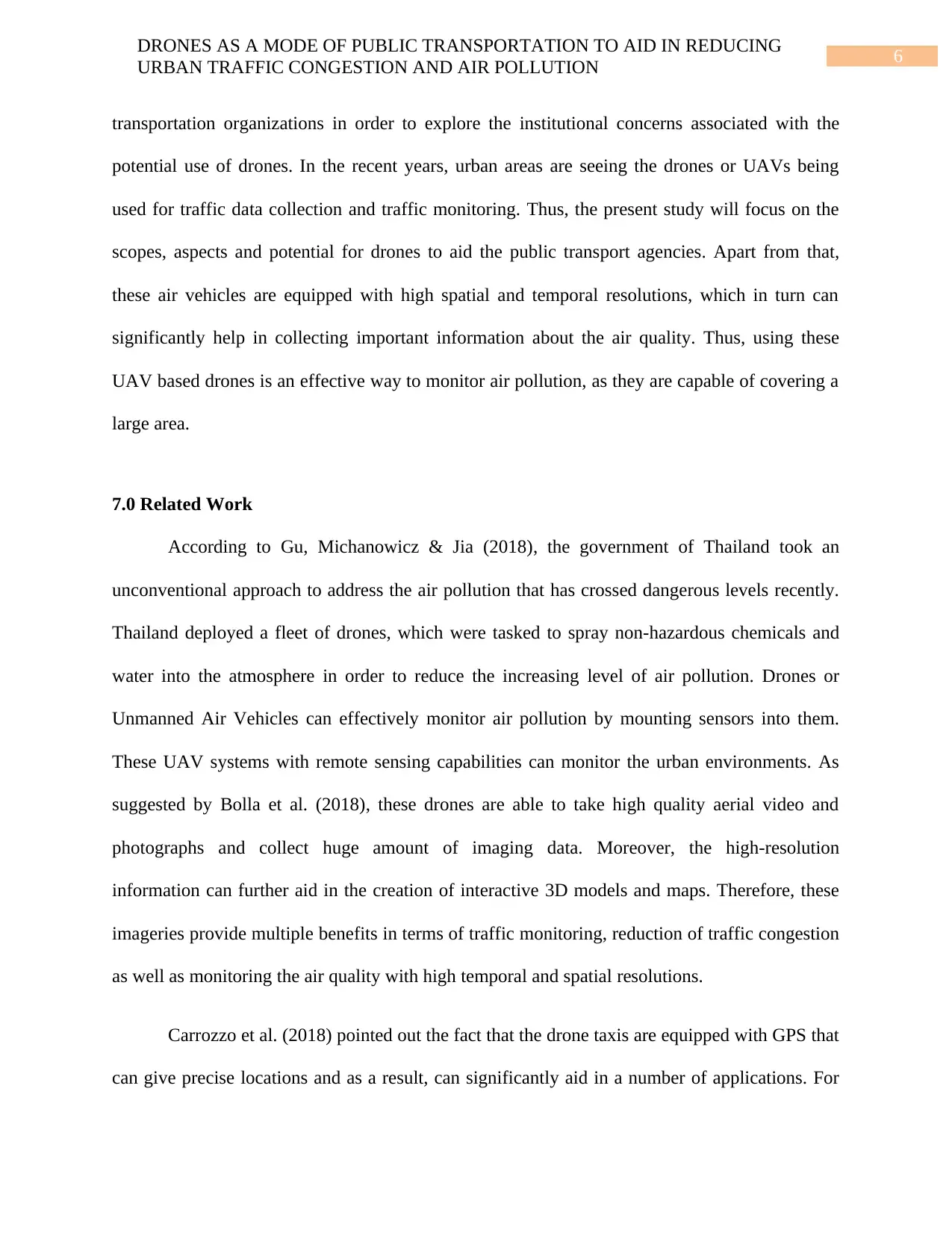
DRONES AS A MODE OF PUBLIC TRANSPORTATION TO AID IN REDUCING
URBAN TRAFFIC CONGESTION AND AIR POLLUTION 6
transportation organizations in order to explore the institutional concerns associated with the
potential use of drones. In the recent years, urban areas are seeing the drones or UAVs being
used for traffic data collection and traffic monitoring. Thus, the present study will focus on the
scopes, aspects and potential for drones to aid the public transport agencies. Apart from that,
these air vehicles are equipped with high spatial and temporal resolutions, which in turn can
significantly help in collecting important information about the air quality. Thus, using these
UAV based drones is an effective way to monitor air pollution, as they are capable of covering a
large area.
7.0 Related Work
According to Gu, Michanowicz & Jia (2018), the government of Thailand took an
unconventional approach to address the air pollution that has crossed dangerous levels recently.
Thailand deployed a fleet of drones, which were tasked to spray non-hazardous chemicals and
water into the atmosphere in order to reduce the increasing level of air pollution. Drones or
Unmanned Air Vehicles can effectively monitor air pollution by mounting sensors into them.
These UAV systems with remote sensing capabilities can monitor the urban environments. As
suggested by Bolla et al. (2018), these drones are able to take high quality aerial video and
photographs and collect huge amount of imaging data. Moreover, the high-resolution
information can further aid in the creation of interactive 3D models and maps. Therefore, these
imageries provide multiple benefits in terms of traffic monitoring, reduction of traffic congestion
as well as monitoring the air quality with high temporal and spatial resolutions.
Carrozzo et al. (2018) pointed out the fact that the drone taxis are equipped with GPS that
can give precise locations and as a result, can significantly aid in a number of applications. For
URBAN TRAFFIC CONGESTION AND AIR POLLUTION 6
transportation organizations in order to explore the institutional concerns associated with the
potential use of drones. In the recent years, urban areas are seeing the drones or UAVs being
used for traffic data collection and traffic monitoring. Thus, the present study will focus on the
scopes, aspects and potential for drones to aid the public transport agencies. Apart from that,
these air vehicles are equipped with high spatial and temporal resolutions, which in turn can
significantly help in collecting important information about the air quality. Thus, using these
UAV based drones is an effective way to monitor air pollution, as they are capable of covering a
large area.
7.0 Related Work
According to Gu, Michanowicz & Jia (2018), the government of Thailand took an
unconventional approach to address the air pollution that has crossed dangerous levels recently.
Thailand deployed a fleet of drones, which were tasked to spray non-hazardous chemicals and
water into the atmosphere in order to reduce the increasing level of air pollution. Drones or
Unmanned Air Vehicles can effectively monitor air pollution by mounting sensors into them.
These UAV systems with remote sensing capabilities can monitor the urban environments. As
suggested by Bolla et al. (2018), these drones are able to take high quality aerial video and
photographs and collect huge amount of imaging data. Moreover, the high-resolution
information can further aid in the creation of interactive 3D models and maps. Therefore, these
imageries provide multiple benefits in terms of traffic monitoring, reduction of traffic congestion
as well as monitoring the air quality with high temporal and spatial resolutions.
Carrozzo et al. (2018) pointed out the fact that the drone taxis are equipped with GPS that
can give precise locations and as a result, can significantly aid in a number of applications. For
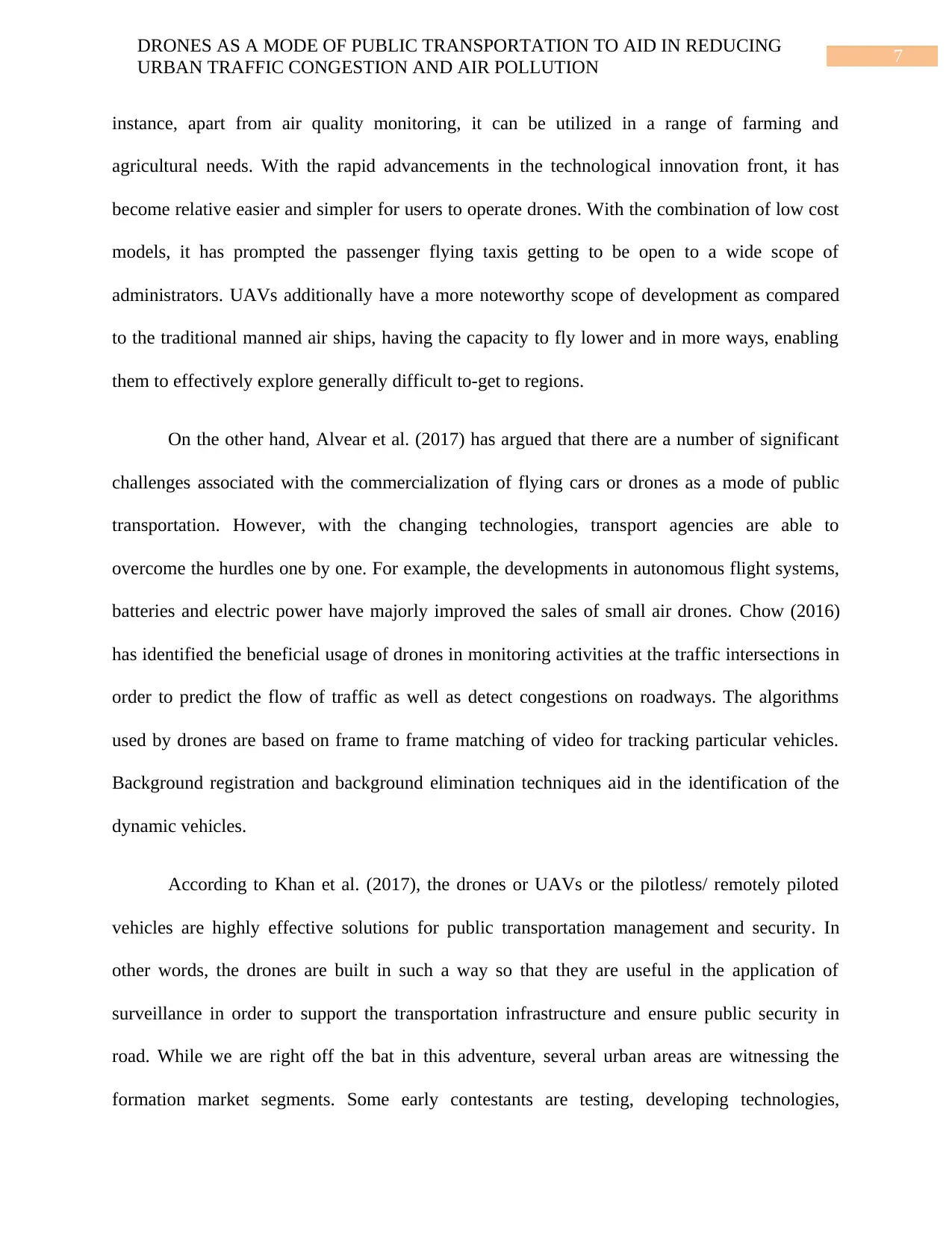
DRONES AS A MODE OF PUBLIC TRANSPORTATION TO AID IN REDUCING
URBAN TRAFFIC CONGESTION AND AIR POLLUTION 7
instance, apart from air quality monitoring, it can be utilized in a range of farming and
agricultural needs. With the rapid advancements in the technological innovation front, it has
become relative easier and simpler for users to operate drones. With the combination of low cost
models, it has prompted the passenger flying taxis getting to be open to a wide scope of
administrators. UAVs additionally have a more noteworthy scope of development as compared
to the traditional manned air ships, having the capacity to fly lower and in more ways, enabling
them to effectively explore generally difficult to-get to regions.
On the other hand, Alvear et al. (2017) has argued that there are a number of significant
challenges associated with the commercialization of flying cars or drones as a mode of public
transportation. However, with the changing technologies, transport agencies are able to
overcome the hurdles one by one. For example, the developments in autonomous flight systems,
batteries and electric power have majorly improved the sales of small air drones. Chow (2016)
has identified the beneficial usage of drones in monitoring activities at the traffic intersections in
order to predict the flow of traffic as well as detect congestions on roadways. The algorithms
used by drones are based on frame to frame matching of video for tracking particular vehicles.
Background registration and background elimination techniques aid in the identification of the
dynamic vehicles.
According to Khan et al. (2017), the drones or UAVs or the pilotless/ remotely piloted
vehicles are highly effective solutions for public transportation management and security. In
other words, the drones are built in such a way so that they are useful in the application of
surveillance in order to support the transportation infrastructure and ensure public security in
road. While we are right off the bat in this adventure, several urban areas are witnessing the
formation market segments. Some early contestants are testing, developing technologies,
URBAN TRAFFIC CONGESTION AND AIR POLLUTION 7
instance, apart from air quality monitoring, it can be utilized in a range of farming and
agricultural needs. With the rapid advancements in the technological innovation front, it has
become relative easier and simpler for users to operate drones. With the combination of low cost
models, it has prompted the passenger flying taxis getting to be open to a wide scope of
administrators. UAVs additionally have a more noteworthy scope of development as compared
to the traditional manned air ships, having the capacity to fly lower and in more ways, enabling
them to effectively explore generally difficult to-get to regions.
On the other hand, Alvear et al. (2017) has argued that there are a number of significant
challenges associated with the commercialization of flying cars or drones as a mode of public
transportation. However, with the changing technologies, transport agencies are able to
overcome the hurdles one by one. For example, the developments in autonomous flight systems,
batteries and electric power have majorly improved the sales of small air drones. Chow (2016)
has identified the beneficial usage of drones in monitoring activities at the traffic intersections in
order to predict the flow of traffic as well as detect congestions on roadways. The algorithms
used by drones are based on frame to frame matching of video for tracking particular vehicles.
Background registration and background elimination techniques aid in the identification of the
dynamic vehicles.
According to Khan et al. (2017), the drones or UAVs or the pilotless/ remotely piloted
vehicles are highly effective solutions for public transportation management and security. In
other words, the drones are built in such a way so that they are useful in the application of
surveillance in order to support the transportation infrastructure and ensure public security in
road. While we are right off the bat in this adventure, several urban areas are witnessing the
formation market segments. Some early contestants are testing, developing technologies,
Paraphrase This Document
Need a fresh take? Get an instant paraphrase of this document with our AI Paraphraser
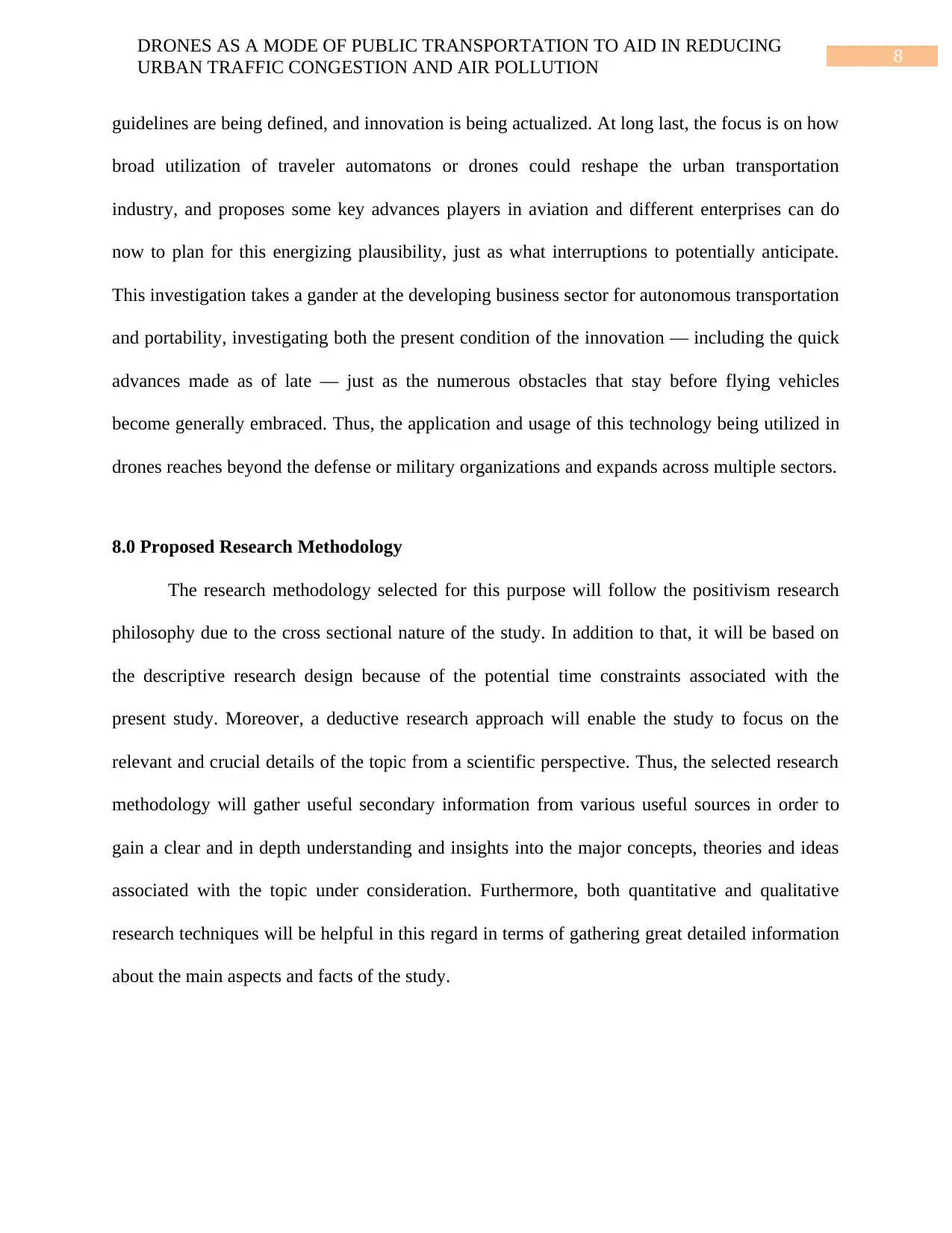
DRONES AS A MODE OF PUBLIC TRANSPORTATION TO AID IN REDUCING
URBAN TRAFFIC CONGESTION AND AIR POLLUTION 8
guidelines are being defined, and innovation is being actualized. At long last, the focus is on how
broad utilization of traveler automatons or drones could reshape the urban transportation
industry, and proposes some key advances players in aviation and different enterprises can do
now to plan for this energizing plausibility, just as what interruptions to potentially anticipate.
This investigation takes a gander at the developing business sector for autonomous transportation
and portability, investigating both the present condition of the innovation — including the quick
advances made as of late — just as the numerous obstacles that stay before flying vehicles
become generally embraced. Thus, the application and usage of this technology being utilized in
drones reaches beyond the defense or military organizations and expands across multiple sectors.
8.0 Proposed Research Methodology
The research methodology selected for this purpose will follow the positivism research
philosophy due to the cross sectional nature of the study. In addition to that, it will be based on
the descriptive research design because of the potential time constraints associated with the
present study. Moreover, a deductive research approach will enable the study to focus on the
relevant and crucial details of the topic from a scientific perspective. Thus, the selected research
methodology will gather useful secondary information from various useful sources in order to
gain a clear and in depth understanding and insights into the major concepts, theories and ideas
associated with the topic under consideration. Furthermore, both quantitative and qualitative
research techniques will be helpful in this regard in terms of gathering great detailed information
about the main aspects and facts of the study.
URBAN TRAFFIC CONGESTION AND AIR POLLUTION 8
guidelines are being defined, and innovation is being actualized. At long last, the focus is on how
broad utilization of traveler automatons or drones could reshape the urban transportation
industry, and proposes some key advances players in aviation and different enterprises can do
now to plan for this energizing plausibility, just as what interruptions to potentially anticipate.
This investigation takes a gander at the developing business sector for autonomous transportation
and portability, investigating both the present condition of the innovation — including the quick
advances made as of late — just as the numerous obstacles that stay before flying vehicles
become generally embraced. Thus, the application and usage of this technology being utilized in
drones reaches beyond the defense or military organizations and expands across multiple sectors.
8.0 Proposed Research Methodology
The research methodology selected for this purpose will follow the positivism research
philosophy due to the cross sectional nature of the study. In addition to that, it will be based on
the descriptive research design because of the potential time constraints associated with the
present study. Moreover, a deductive research approach will enable the study to focus on the
relevant and crucial details of the topic from a scientific perspective. Thus, the selected research
methodology will gather useful secondary information from various useful sources in order to
gain a clear and in depth understanding and insights into the major concepts, theories and ideas
associated with the topic under consideration. Furthermore, both quantitative and qualitative
research techniques will be helpful in this regard in terms of gathering great detailed information
about the main aspects and facts of the study.
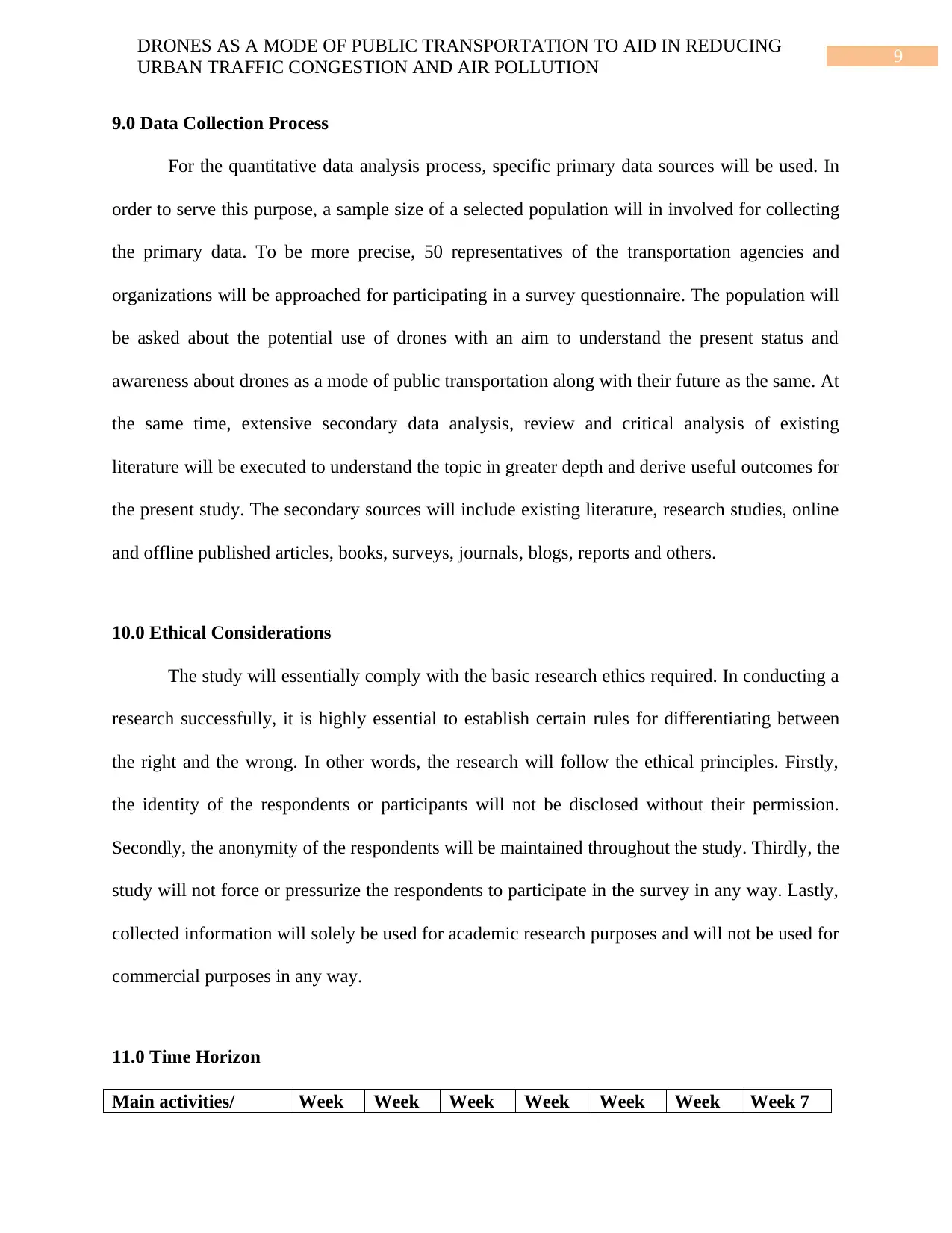
DRONES AS A MODE OF PUBLIC TRANSPORTATION TO AID IN REDUCING
URBAN TRAFFIC CONGESTION AND AIR POLLUTION 9
9.0 Data Collection Process
For the quantitative data analysis process, specific primary data sources will be used. In
order to serve this purpose, a sample size of a selected population will in involved for collecting
the primary data. To be more precise, 50 representatives of the transportation agencies and
organizations will be approached for participating in a survey questionnaire. The population will
be asked about the potential use of drones with an aim to understand the present status and
awareness about drones as a mode of public transportation along with their future as the same. At
the same time, extensive secondary data analysis, review and critical analysis of existing
literature will be executed to understand the topic in greater depth and derive useful outcomes for
the present study. The secondary sources will include existing literature, research studies, online
and offline published articles, books, surveys, journals, blogs, reports and others.
10.0 Ethical Considerations
The study will essentially comply with the basic research ethics required. In conducting a
research successfully, it is highly essential to establish certain rules for differentiating between
the right and the wrong. In other words, the research will follow the ethical principles. Firstly,
the identity of the respondents or participants will not be disclosed without their permission.
Secondly, the anonymity of the respondents will be maintained throughout the study. Thirdly, the
study will not force or pressurize the respondents to participate in the survey in any way. Lastly,
collected information will solely be used for academic research purposes and will not be used for
commercial purposes in any way.
11.0 Time Horizon
Main activities/ Week Week Week Week Week Week Week 7
URBAN TRAFFIC CONGESTION AND AIR POLLUTION 9
9.0 Data Collection Process
For the quantitative data analysis process, specific primary data sources will be used. In
order to serve this purpose, a sample size of a selected population will in involved for collecting
the primary data. To be more precise, 50 representatives of the transportation agencies and
organizations will be approached for participating in a survey questionnaire. The population will
be asked about the potential use of drones with an aim to understand the present status and
awareness about drones as a mode of public transportation along with their future as the same. At
the same time, extensive secondary data analysis, review and critical analysis of existing
literature will be executed to understand the topic in greater depth and derive useful outcomes for
the present study. The secondary sources will include existing literature, research studies, online
and offline published articles, books, surveys, journals, blogs, reports and others.
10.0 Ethical Considerations
The study will essentially comply with the basic research ethics required. In conducting a
research successfully, it is highly essential to establish certain rules for differentiating between
the right and the wrong. In other words, the research will follow the ethical principles. Firstly,
the identity of the respondents or participants will not be disclosed without their permission.
Secondly, the anonymity of the respondents will be maintained throughout the study. Thirdly, the
study will not force or pressurize the respondents to participate in the survey in any way. Lastly,
collected information will solely be used for academic research purposes and will not be used for
commercial purposes in any way.
11.0 Time Horizon
Main activities/ Week Week Week Week Week Week Week 7
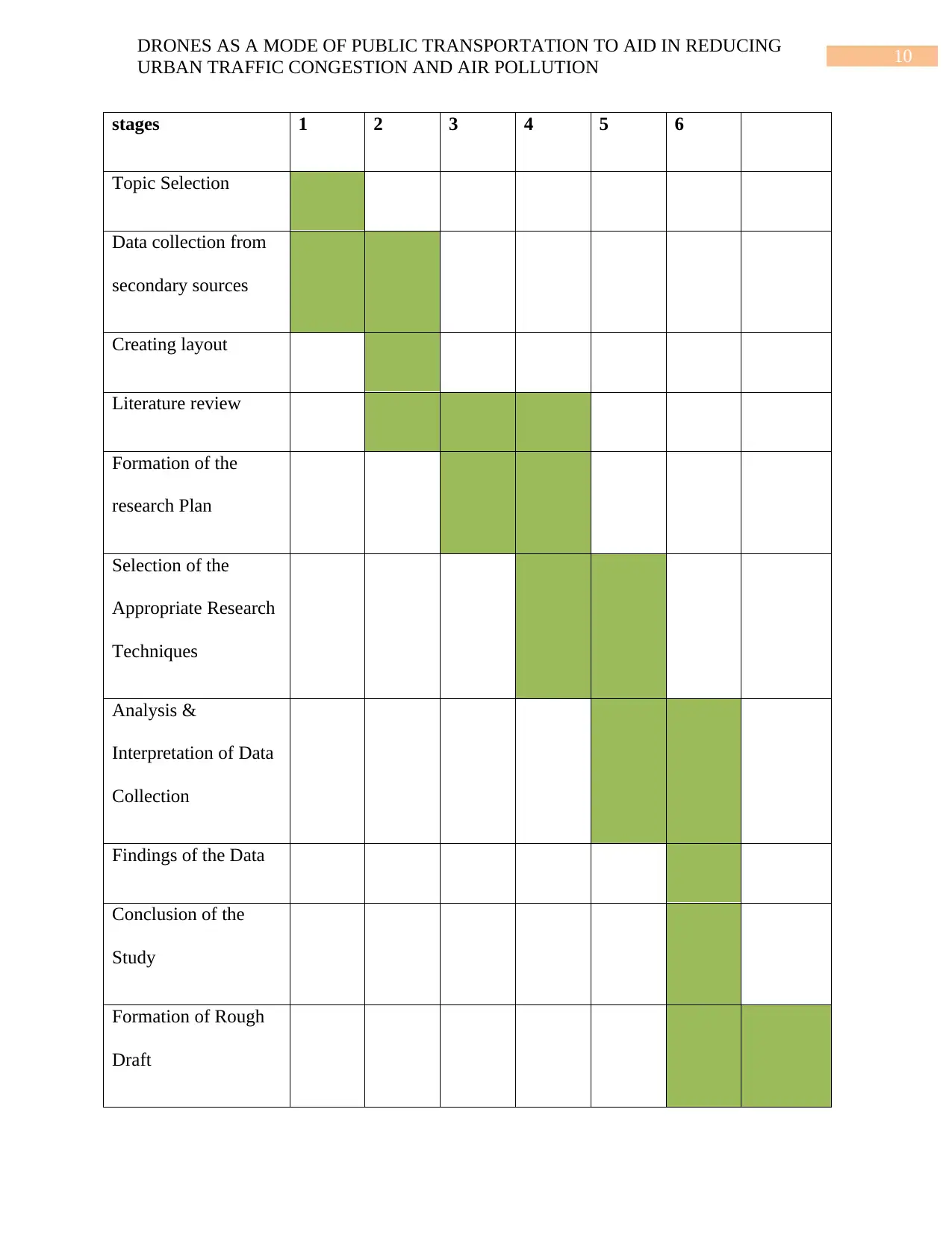
DRONES AS A MODE OF PUBLIC TRANSPORTATION TO AID IN REDUCING
URBAN TRAFFIC CONGESTION AND AIR POLLUTION 10
stages 1 2 3 4 5 6
Topic Selection
Data collection from
secondary sources
Creating layout
Literature review
Formation of the
research Plan
Selection of the
Appropriate Research
Techniques
Analysis &
Interpretation of Data
Collection
Findings of the Data
Conclusion of the
Study
Formation of Rough
Draft
URBAN TRAFFIC CONGESTION AND AIR POLLUTION 10
stages 1 2 3 4 5 6
Topic Selection
Data collection from
secondary sources
Creating layout
Literature review
Formation of the
research Plan
Selection of the
Appropriate Research
Techniques
Analysis &
Interpretation of Data
Collection
Findings of the Data
Conclusion of the
Study
Formation of Rough
Draft
Secure Best Marks with AI Grader
Need help grading? Try our AI Grader for instant feedback on your assignments.
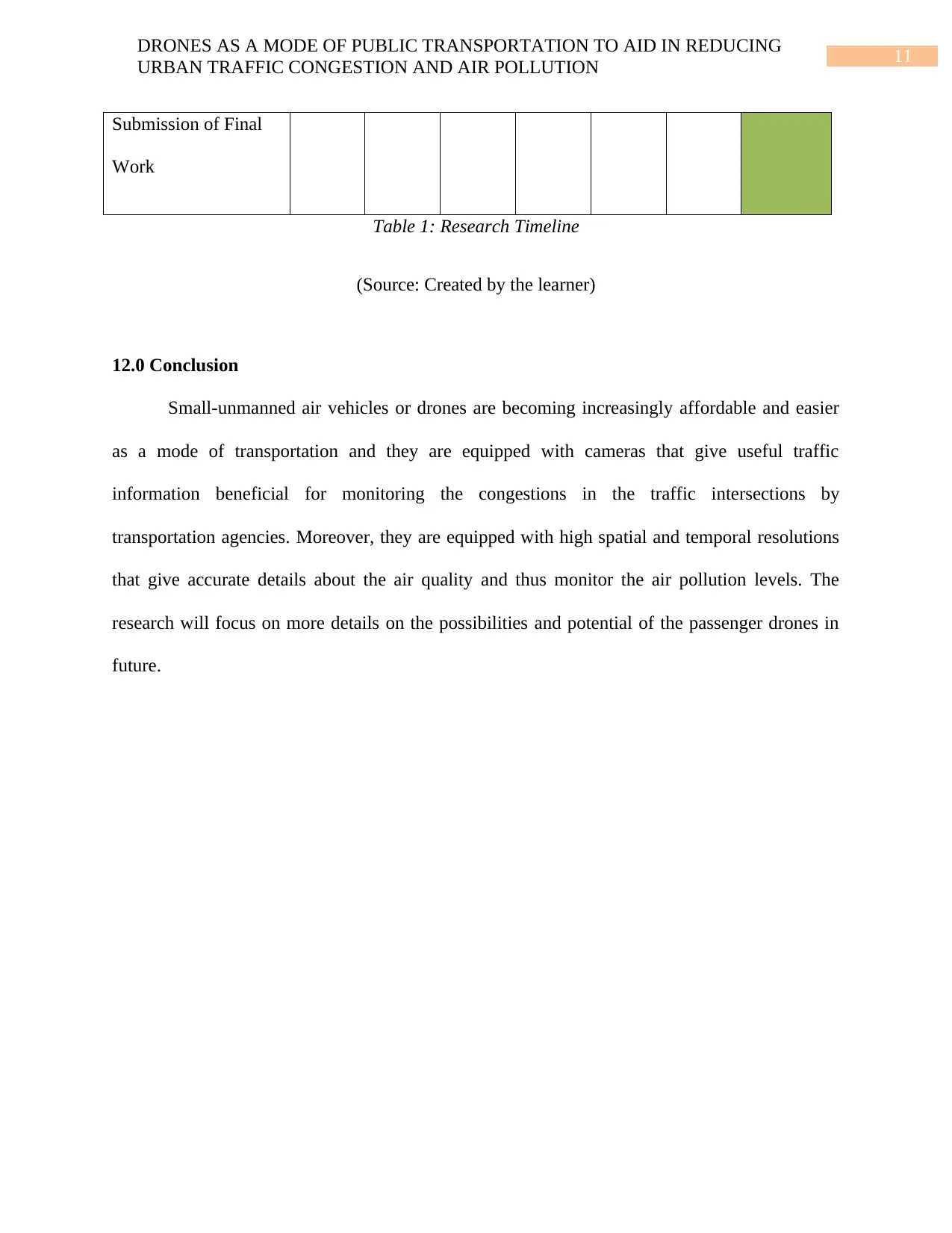
DRONES AS A MODE OF PUBLIC TRANSPORTATION TO AID IN REDUCING
URBAN TRAFFIC CONGESTION AND AIR POLLUTION 11
Submission of Final
Work
Table 1: Research Timeline
(Source: Created by the learner)
12.0 Conclusion
Small-unmanned air vehicles or drones are becoming increasingly affordable and easier
as a mode of transportation and they are equipped with cameras that give useful traffic
information beneficial for monitoring the congestions in the traffic intersections by
transportation agencies. Moreover, they are equipped with high spatial and temporal resolutions
that give accurate details about the air quality and thus monitor the air pollution levels. The
research will focus on more details on the possibilities and potential of the passenger drones in
future.
URBAN TRAFFIC CONGESTION AND AIR POLLUTION 11
Submission of Final
Work
Table 1: Research Timeline
(Source: Created by the learner)
12.0 Conclusion
Small-unmanned air vehicles or drones are becoming increasingly affordable and easier
as a mode of transportation and they are equipped with cameras that give useful traffic
information beneficial for monitoring the congestions in the traffic intersections by
transportation agencies. Moreover, they are equipped with high spatial and temporal resolutions
that give accurate details about the air quality and thus monitor the air pollution levels. The
research will focus on more details on the possibilities and potential of the passenger drones in
future.
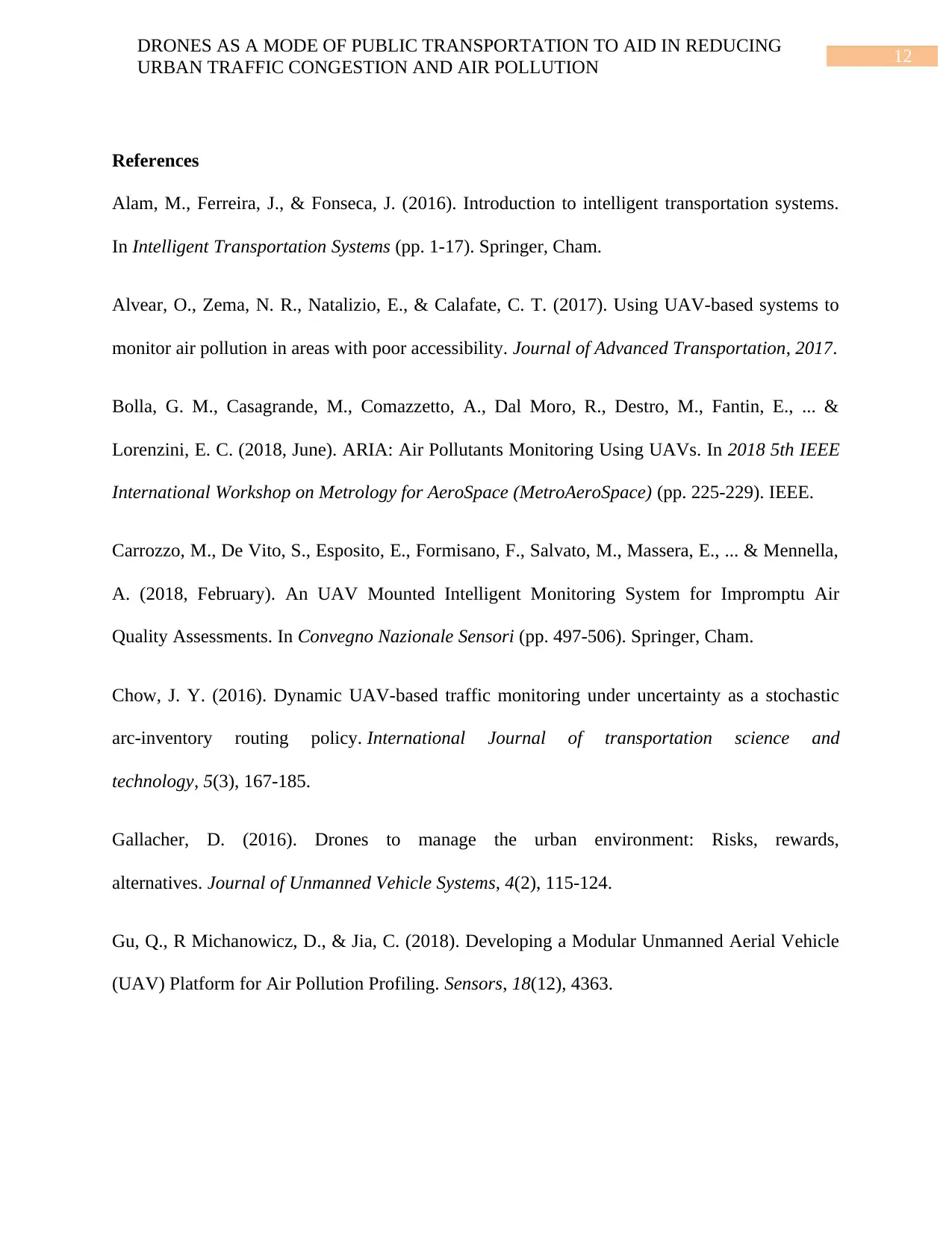
DRONES AS A MODE OF PUBLIC TRANSPORTATION TO AID IN REDUCING
URBAN TRAFFIC CONGESTION AND AIR POLLUTION 12
References
Alam, M., Ferreira, J., & Fonseca, J. (2016). Introduction to intelligent transportation systems.
In Intelligent Transportation Systems (pp. 1-17). Springer, Cham.
Alvear, O., Zema, N. R., Natalizio, E., & Calafate, C. T. (2017). Using UAV-based systems to
monitor air pollution in areas with poor accessibility. Journal of Advanced Transportation, 2017.
Bolla, G. M., Casagrande, M., Comazzetto, A., Dal Moro, R., Destro, M., Fantin, E., ... &
Lorenzini, E. C. (2018, June). ARIA: Air Pollutants Monitoring Using UAVs. In 2018 5th IEEE
International Workshop on Metrology for AeroSpace (MetroAeroSpace) (pp. 225-229). IEEE.
Carrozzo, M., De Vito, S., Esposito, E., Formisano, F., Salvato, M., Massera, E., ... & Mennella,
A. (2018, February). An UAV Mounted Intelligent Monitoring System for Impromptu Air
Quality Assessments. In Convegno Nazionale Sensori (pp. 497-506). Springer, Cham.
Chow, J. Y. (2016). Dynamic UAV-based traffic monitoring under uncertainty as a stochastic
arc-inventory routing policy. International Journal of transportation science and
technology, 5(3), 167-185.
Gallacher, D. (2016). Drones to manage the urban environment: Risks, rewards,
alternatives. Journal of Unmanned Vehicle Systems, 4(2), 115-124.
Gu, Q., R Michanowicz, D., & Jia, C. (2018). Developing a Modular Unmanned Aerial Vehicle
(UAV) Platform for Air Pollution Profiling. Sensors, 18(12), 4363.
URBAN TRAFFIC CONGESTION AND AIR POLLUTION 12
References
Alam, M., Ferreira, J., & Fonseca, J. (2016). Introduction to intelligent transportation systems.
In Intelligent Transportation Systems (pp. 1-17). Springer, Cham.
Alvear, O., Zema, N. R., Natalizio, E., & Calafate, C. T. (2017). Using UAV-based systems to
monitor air pollution in areas with poor accessibility. Journal of Advanced Transportation, 2017.
Bolla, G. M., Casagrande, M., Comazzetto, A., Dal Moro, R., Destro, M., Fantin, E., ... &
Lorenzini, E. C. (2018, June). ARIA: Air Pollutants Monitoring Using UAVs. In 2018 5th IEEE
International Workshop on Metrology for AeroSpace (MetroAeroSpace) (pp. 225-229). IEEE.
Carrozzo, M., De Vito, S., Esposito, E., Formisano, F., Salvato, M., Massera, E., ... & Mennella,
A. (2018, February). An UAV Mounted Intelligent Monitoring System for Impromptu Air
Quality Assessments. In Convegno Nazionale Sensori (pp. 497-506). Springer, Cham.
Chow, J. Y. (2016). Dynamic UAV-based traffic monitoring under uncertainty as a stochastic
arc-inventory routing policy. International Journal of transportation science and
technology, 5(3), 167-185.
Gallacher, D. (2016). Drones to manage the urban environment: Risks, rewards,
alternatives. Journal of Unmanned Vehicle Systems, 4(2), 115-124.
Gu, Q., R Michanowicz, D., & Jia, C. (2018). Developing a Modular Unmanned Aerial Vehicle
(UAV) Platform for Air Pollution Profiling. Sensors, 18(12), 4363.
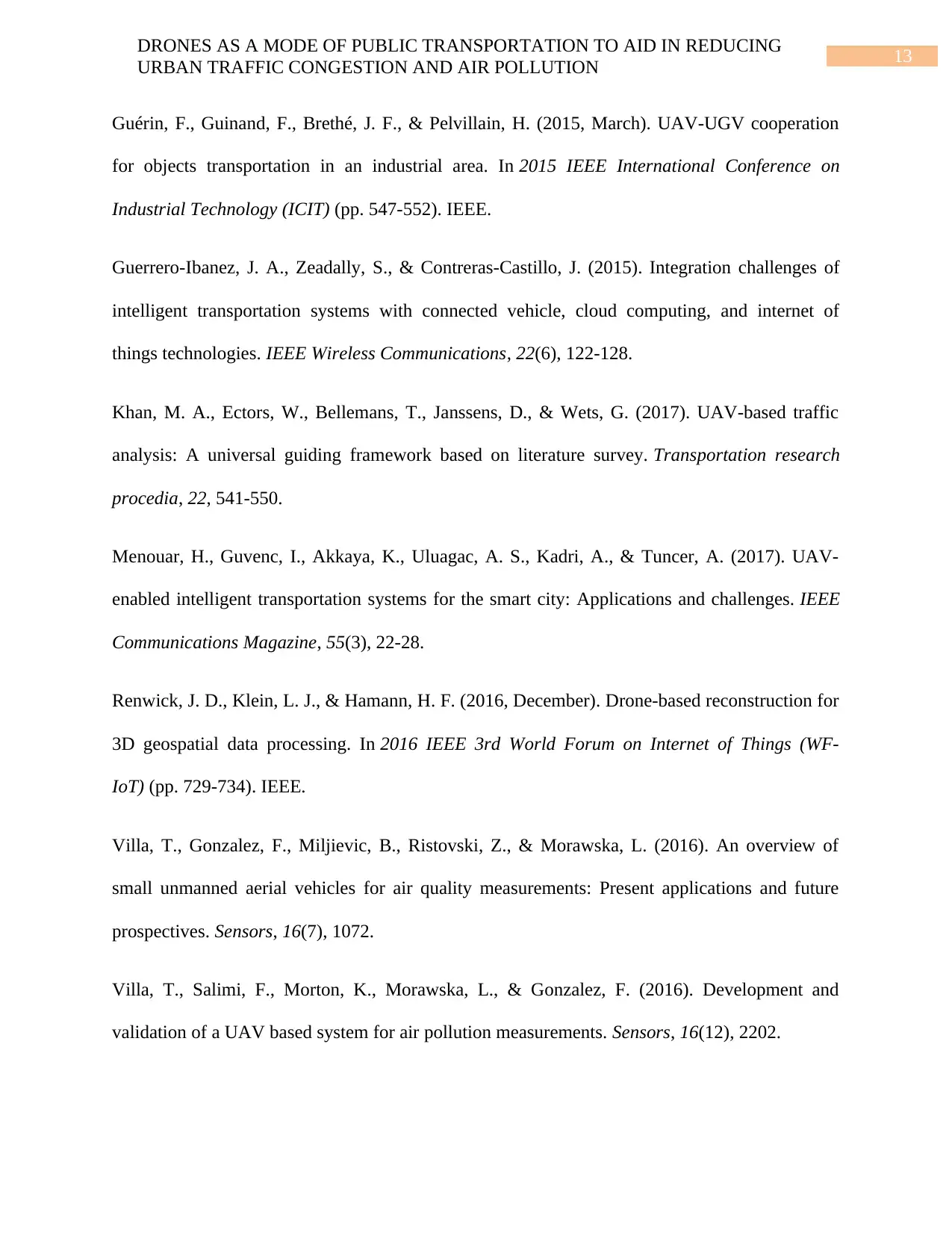
DRONES AS A MODE OF PUBLIC TRANSPORTATION TO AID IN REDUCING
URBAN TRAFFIC CONGESTION AND AIR POLLUTION 13
Guérin, F., Guinand, F., Brethé, J. F., & Pelvillain, H. (2015, March). UAV-UGV cooperation
for objects transportation in an industrial area. In 2015 IEEE International Conference on
Industrial Technology (ICIT) (pp. 547-552). IEEE.
Guerrero-Ibanez, J. A., Zeadally, S., & Contreras-Castillo, J. (2015). Integration challenges of
intelligent transportation systems with connected vehicle, cloud computing, and internet of
things technologies. IEEE Wireless Communications, 22(6), 122-128.
Khan, M. A., Ectors, W., Bellemans, T., Janssens, D., & Wets, G. (2017). UAV-based traffic
analysis: A universal guiding framework based on literature survey. Transportation research
procedia, 22, 541-550.
Menouar, H., Guvenc, I., Akkaya, K., Uluagac, A. S., Kadri, A., & Tuncer, A. (2017). UAV-
enabled intelligent transportation systems for the smart city: Applications and challenges. IEEE
Communications Magazine, 55(3), 22-28.
Renwick, J. D., Klein, L. J., & Hamann, H. F. (2016, December). Drone-based reconstruction for
3D geospatial data processing. In 2016 IEEE 3rd World Forum on Internet of Things (WF-
IoT) (pp. 729-734). IEEE.
Villa, T., Gonzalez, F., Miljievic, B., Ristovski, Z., & Morawska, L. (2016). An overview of
small unmanned aerial vehicles for air quality measurements: Present applications and future
prospectives. Sensors, 16(7), 1072.
Villa, T., Salimi, F., Morton, K., Morawska, L., & Gonzalez, F. (2016). Development and
validation of a UAV based system for air pollution measurements. Sensors, 16(12), 2202.
URBAN TRAFFIC CONGESTION AND AIR POLLUTION 13
Guérin, F., Guinand, F., Brethé, J. F., & Pelvillain, H. (2015, March). UAV-UGV cooperation
for objects transportation in an industrial area. In 2015 IEEE International Conference on
Industrial Technology (ICIT) (pp. 547-552). IEEE.
Guerrero-Ibanez, J. A., Zeadally, S., & Contreras-Castillo, J. (2015). Integration challenges of
intelligent transportation systems with connected vehicle, cloud computing, and internet of
things technologies. IEEE Wireless Communications, 22(6), 122-128.
Khan, M. A., Ectors, W., Bellemans, T., Janssens, D., & Wets, G. (2017). UAV-based traffic
analysis: A universal guiding framework based on literature survey. Transportation research
procedia, 22, 541-550.
Menouar, H., Guvenc, I., Akkaya, K., Uluagac, A. S., Kadri, A., & Tuncer, A. (2017). UAV-
enabled intelligent transportation systems for the smart city: Applications and challenges. IEEE
Communications Magazine, 55(3), 22-28.
Renwick, J. D., Klein, L. J., & Hamann, H. F. (2016, December). Drone-based reconstruction for
3D geospatial data processing. In 2016 IEEE 3rd World Forum on Internet of Things (WF-
IoT) (pp. 729-734). IEEE.
Villa, T., Gonzalez, F., Miljievic, B., Ristovski, Z., & Morawska, L. (2016). An overview of
small unmanned aerial vehicles for air quality measurements: Present applications and future
prospectives. Sensors, 16(7), 1072.
Villa, T., Salimi, F., Morton, K., Morawska, L., & Gonzalez, F. (2016). Development and
validation of a UAV based system for air pollution measurements. Sensors, 16(12), 2202.
Paraphrase This Document
Need a fresh take? Get an instant paraphrase of this document with our AI Paraphraser
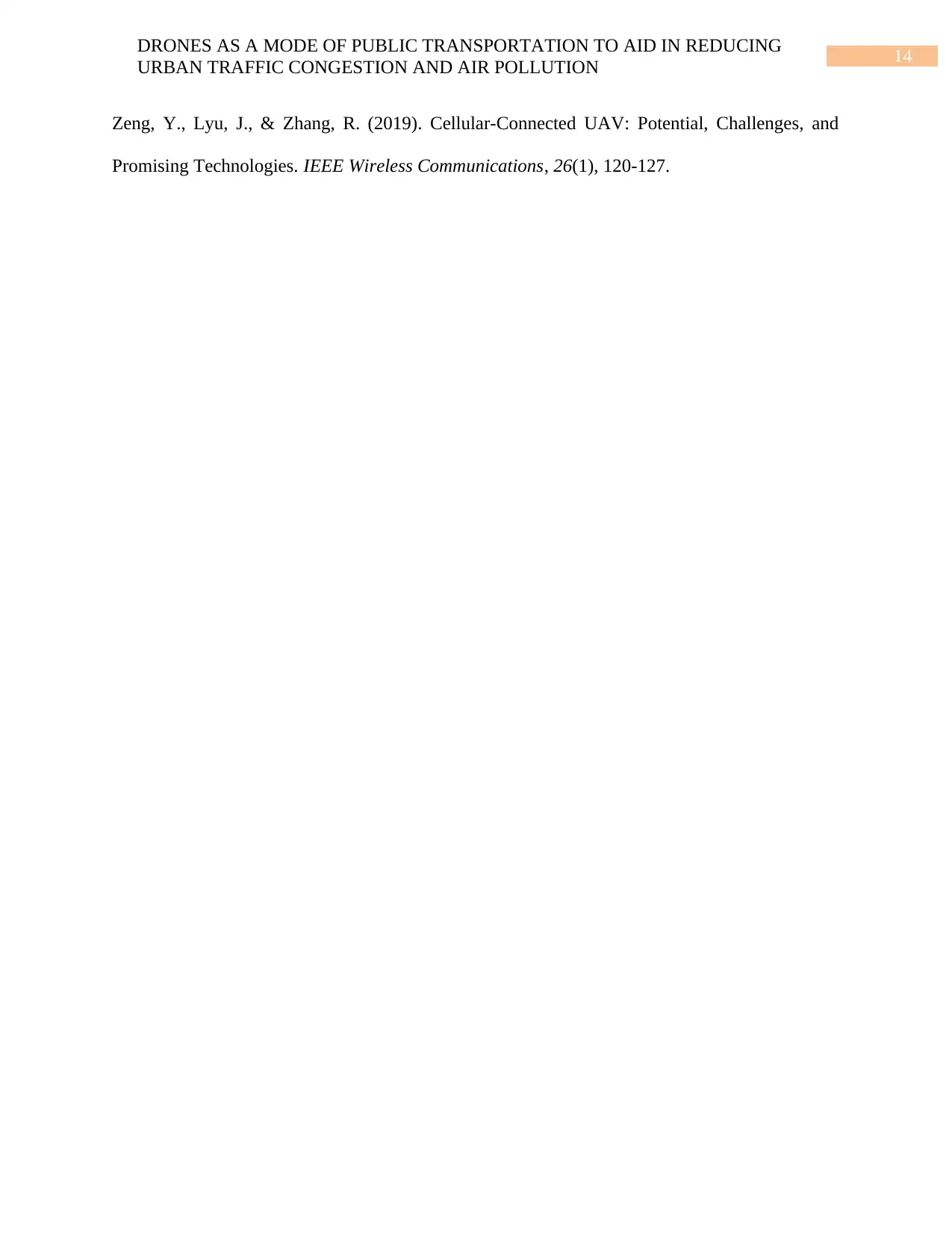
DRONES AS A MODE OF PUBLIC TRANSPORTATION TO AID IN REDUCING
URBAN TRAFFIC CONGESTION AND AIR POLLUTION 14
Zeng, Y., Lyu, J., & Zhang, R. (2019). Cellular-Connected UAV: Potential, Challenges, and
Promising Technologies. IEEE Wireless Communications, 26(1), 120-127.
URBAN TRAFFIC CONGESTION AND AIR POLLUTION 14
Zeng, Y., Lyu, J., & Zhang, R. (2019). Cellular-Connected UAV: Potential, Challenges, and
Promising Technologies. IEEE Wireless Communications, 26(1), 120-127.
1 out of 14
Related Documents
Your All-in-One AI-Powered Toolkit for Academic Success.
+13062052269
info@desklib.com
Available 24*7 on WhatsApp / Email
![[object Object]](/_next/static/media/star-bottom.7253800d.svg)
Unlock your academic potential
© 2024 | Zucol Services PVT LTD | All rights reserved.





